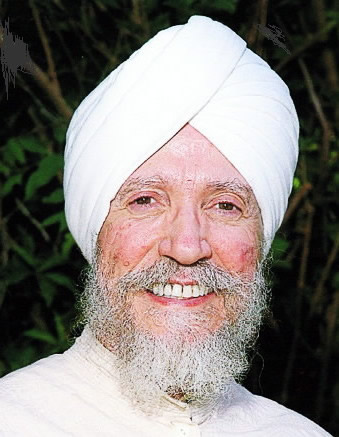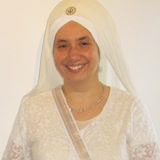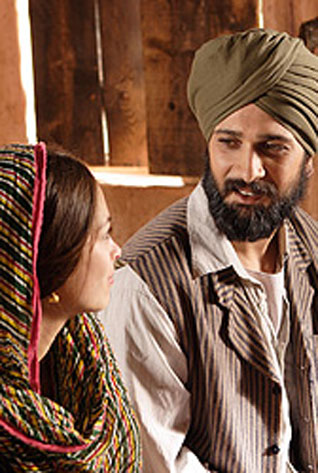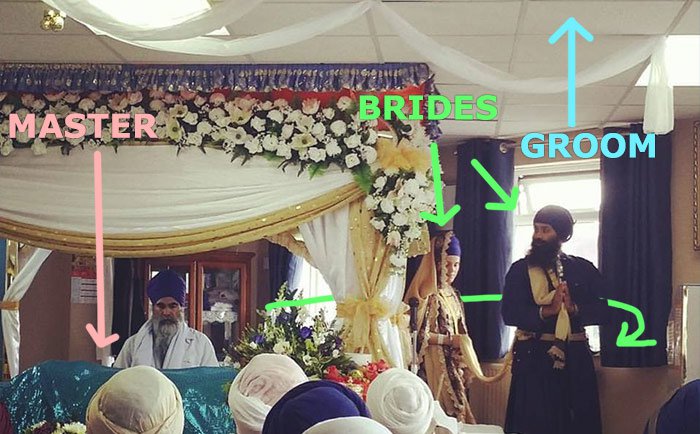My Sikh Sense

Hari Singh BIrd Khalsa
Mixed Marriage of Sikhs
August 26, 2015
Sat Nam. It appears that Sikh Dharma, U.S., and the world over is struggling with internal issues regarding Tribalism? Whereas, Sikh Dharma should be a worldwide exemplary model, and in the forefront of Pluralism by practicing what we teach, as did Guru Nanak and Yogi Bhajan. (See Anand Karaj. See Couple Forced To Marry Privately.)
Please read on. --

FROM: SOHAN SINGH, ENGLAND
Isn't it ironical that while SikhNet and other organisations in U.S.A. are organising a Sri Guru Granth Sahib Conference the theme of which is: The timeless, universal message of Sri Guru Granth Sahib - across centuries, cultures, religions and continents - organisations in the United Kingdom are saying that mixed marriages are not permitted in our Gurdwaras? A Gurdwara is a gateway of the Guru: where Sri Guru Granth Sahib is appropriately installed.
Sohan Singh, England --

FROM: JAGPAL SINGH TIWANA, DARTMOUTH, CANADA
May I humbly request the Sikh Council of UK to please consider the following question before they declare any opinion on the issue of mixed marriages.
1) Is there any evidence of any Guru Sahib asking anyone to become a Sikh before they can come to Guru Darbar and seek blessing?
2) Is there any evidence in Gurbani that one must convert to Sikh Dharma before they can be blessed with Gurbani message?
3) The Sikh Rehat Maryada is written by Sikhs between 1925 band 1946. Is there any evidence indicating any Guru Sahib ever mandated such a rule for the bride and groom seeking their blessings?
4) Is the message of any of the four LAVAN applicable to SIkhs only?
If the answers to the above questions is NO, then maybe the Sikh Council of UK can look at the evidence in Gurbani message indicating equality among humanity?
Maybe Sikh Council of UK can get some message from the Langar practice started by Guru Sahibs themselves. Maybe we can follow the same philosophy and treat everyone equal in marriage ceremony.
Please also consider: Is there any evidence in Guru Granth Sahib message (a Gurbani quote) that circling around the Guru Granth Sahib has any meaning or value at all? If not why do Sikhs borrow this ritual from other faiths? It should be stopped only if to preserve the gender equality as well, otherwise making bride walk behind the groom is clear mandating an inequality which is clearly against the Gurbani message and hence a highest disrespect of Guru Sahib right in Guru Sahib's presence.
The decision coming out of this deliberation will indicate if the Sikh Council follows Guru Granth Sahib philosophy OR they ignore the Gurbani message in favor of Maryada which in this case is inconsistent with the Gurbani message.
Another practical point to consider is the feelings of Sikh parents who wish their child to marry in presence of Sri Guru Granth Sahib and the child is following the Gurbani message of treating everyone equal regardless of their faith. (There is no evidence in Gurbani where there is any indication forbidding marriage outside one's faith.)
These are only a few of my points, I am sure there are many other points for Sikh Council of UK to consider. Please be careful to keep Gurbani message above any other Maryada written by Sikh Scholars under the influence of the British Government and the agencies that themselves and developed their own Maryada and do not follow this Sikh Rehat Maryada.
Chardi Kalaa,
Jagpal Singh Tiwana, Dartmouth, Canada --
Click here to add your thoughts. Read me first.
 
My Sikh Sense

Siri Narayan Kaur Khalsa Fuda
Mixed Marriage of Sikhs
Sat Nam Ji! This whole marriage thing is very interesting to me.
My husband and I have now been married for 53 years. Our first ceremony was Catholic with only our immediate families and a very few closest friends in attendance. At the time my husband (the son of a very devout Lutheran family) considered himself a born again atheist and I was a practicing Roman Catholic. Twenty-five years later we celebrated our anniversary by having a Lavan at our home in the kundalini yoga/Gurdwara space.
The officiant was Hari Nam Singh of Toronto. We followed advice from Yogi Bhajan given by old fashioned snail mail. In all matters of spiritual concern we followed tradition, including circling the Sri Guru Granth Sahib during the reciting the Lavan. We walked side by side,however, with our shawl covering both of us (still one of our most loved possessions).
After the ceremony we had a lovely Langar, prepared by our yoga students with some items from a nearby restaurant run by a Sikh family. At that time my husband was no longer a complete atheist, but still a sceptic. (He now considers himself a rational agnostic.) I had taken amrit and always dressed in bona, even while teaching in a Buffalo public school.
I guess the point I'm making is that we're still married. I am still a Sikh, and my husband is still a physicist. It is not incompatible. And in no way was either of our marriage ceremonies other than deeply profound, a joining, or perhaps rejoining, of two souls in an ancient love relationship. My husband has always been supportive of my practice and my teaching. And over the years his personal habits have moderated and become more happy, healthy, and (sorta) holy.
Besides, was Guru Nanak's wife (Mata Sulakhani) a Sikh?
Come on, guys, Ek Ong Kar!
May you and yours always be blessed in all ways.
SS Siri Narayan Kaur Khalsa Fuda --
See Women Wimps or Warriors.
Click here to add your thoughts. Read me first.
 
My Sikh Sense

Ek Ong Kaar Kaur Khalsa
Life Partner: Letters from Espanola
Sat Nam. In September (2015), I was blessed to attend a conference focusing on the Universal Message of Guru Granth Sahib at the gurdwara in San Jose, California, USA. The conference was co-sponsored by the Gurdwara San Jose, the Chardi Kalaa Foundation and SikhNet.com.
I shared a paper on Guru Arjan's four letters to Guru Ram Das, known as Shabad Hazaaray. On how those letters can give an insight about the true nature of love.
The people at the conference enjoyed the presentation very much, and I appreciated their kind words about it. However, at the very end of the day, a lovely young Sikh man, in his late 20s, came to speak with me. He said, "I am of a marriageable age. How do I go about choosing a partner?"
I am embarrassed to say that I did not really have a good answer for him. I started talking about how marriages that lasted were because the partners just somehow "knew" that they were right for each other. And how he should develop his intuition through simran.
He listened to me respectfully, but I could tell my words did not give him what he needed.
So I have been thinking deeply about his question for the last month, and wanted to share my thoughts about it.
Mind you, I am a middle-aged single woman who has lived a very singular life. I was not born Sikh, and in my early 20s, I was a bit of a wild child. Relationships started for me in a way that modern Western media tends to glorify. What I can say from experience is that this approach is not a bad short-term strategy, but not really a great long-term one.
So to answer this young man who asked such a heart-felt question, I would like to share some insights from my own life. And if they help him or anyone to understand partnerships better, then something positive might come from my own life journey.
The first thing I want to say is that just because you love someone does not mean that you will be able to live with them for the rest of your life. This is one of the most painful and important lessons I have learned. You can love someone deeply, but that person may not necessarily be the right life partner.
Why? Because a life partner depends on more than just love. Life partners need a shared vision of life. Shared values. A shared sense of direction. These things matter as much, if not more, than being "in love" with someone.
Singh Sahib Harbhajan Singh ji Yogi once gave a lecture where he said to women, "Do not make decisions based on being in love."I asked him, then what do you base your decisions on?
He replied: "Values, virtues and character."
I think this is a really great framework for everyone. Being in love can blind you a little bit. You may go to bed with the physical beauty of a person. But you wake up with their character. So study the character of the other person first.
What are their habits? What are their values? What are their virtues? And will the character, values and virtues bring something positive to your life?
To make a good decision about a life partner, I would offer that you need two things. A certain set of skills and a process.
SKILLS
When it comes to partnership, what skills are good to bring to the table? The first skill is Simran. You cannot really succeed in any relationship with anyone until you first establish your relationship between your own inner being and your own mind. That relationship has to come first.
So know yourself. Have a connection to your core. Do something spiritual for yourself every day. Have roots with your own being. It will keep you steady because all relationships involve ups and down. Your own steadiness within yourself will see you through the good and the tough times.
Then, I would offer - find out if you can do simran with your potential partner. The family that prays together, stays together. To me, this is one of the most critical skills between partners. Can you do your banis, or sing kirtan, or do simran together? Sharing a spiritual practice, believe it or not, can really solve a lot of problems in the sacred space before they make it to time and space.
The second skill that I would suggest you bring to the table is something I call Authentic Allowing. Too often, in the search for partnership, we twist ourselves into something that we think we should be in order to gain the approval of another. It is a very human, fallible reality that can happen in partnership. But in time, we will want to drop the mask and be loved for who we actually are. And if our partner rejects us, that can lead to pain and resentment.
You need a certain courage to just be as authentic as possible with another person.
And then, allow them to be as authentic as possible with you. This is where simran is so critical. Do not seek your sense of self worth from another person. Do not make it a life or death issue whether someone will accept you. Just be you. Just give the other person profound permission to be who he or she is.
If in that Authentic Allowing, a genuine connection of enjoyment and appreciation gets created, you have found something worthwhile.
The third, incredibly critical, skill is communication. And communication begins with listening. Reflective listening is one of the most important lessons you can learn for every type of relationship. Reflective listening means - I listen to what you say and before I respond, I tell you what I have heard. "What I hear you saying is ..." This type of skill helps during moments of conflict. So bring really good reflective listening skills to the table.
The other side of good communication is that you communicate from your consciousness, not from your emotions. It is okay to feel things. But do not inject your emotions into another person. To say, "I am angry with you because of x, y and z; and I need such and such from you!" is far better than to yell and scream and break things.
So speak consciously, not emotionally. These skills will help build trust and intimacy in a relationship.
PROCESS

The second aspect to finding partnership has to do with the process you go through together. I think it is important for people to be honest with each other. If you would like a marriage partner, state it up front. If the other person is not ready for marriage and you are, let them walk away. If you just want to have a good time, say it up front. You will find someone else who also wants a good time.
Do not fake it, just be real and let your authentic truth attract the person who
matches what you are looking for.
When it comes to marriage, here is the other painful and important lesson I have learned in my life. Marriage is like founding a company. You will create a home with another person. And the home is kind of like a business for the heart. So what is your vision for your home life? What is the purpose of your home? What is your job description for your potential mate? And what do you have to offer?
Write it all out. Discuss it with each other. Money. Sex. Family. Work. Food. Chores ...
Spend time thinking about what you need from your home life in all of these areas. What are your negotiables? What are your non-negotiables? Create a blue print for what you want to build spiritually, emotionally, psychologically, physically in your home. And dialogue with your potential partner about it. See if you can come up with a common vision and common direction.
It might seem very unromantic on a certain level. But of course, see if you can have fun together. Dining and movies and concerts and all of that. But the fact is, marriage is mostly a diplomatic negotiation between two people across all these home business areas.
So if you will spend the rest of your life dealing with these things, then invest the time talking about them upfront. Maybe even write a document that talks about your goals, and agreements. And be willing to revisit that document every year or so.
Think it through. See if the other person will be a good business partner for the company you want to build called a home and family.
Yogi ji also said, "Be friends, first."
 
Spend time building a friendship. Because when challenges and tests come in relationship, friendship can see you through.
Now let me say a word about sex. Our religious teachings say no sex until after you are married. The reality is not everyone will listen to that. So what I would advise is very simple. No sex until both partners are absolutely sure they are ready to take that step together. Sex should not come early, in my opinion.
Wait to see that the other conversations feel very positive before taking that step. If both partners choose to wait until marriage, great. If both partners feel comfortable with sex earlier, fine. If one partner wants to wait and the other creates pressure and does not have the patience to wait, that potentially could be a deal breaker.
Sex needs trust, and builds trust. So make sex a trust building activity in the relationship, not an animal urge that needs a release.
Doing simran together can help with that.
Skills and Process. Friendship. Character. Values. Virtues. Know that you can love someone but it may not be the right life partner. Invest the time to think about what your home needs to be.
Think about it like a company. Talk about it. Come up with a common vision and common direction. Those are my suggestions to help you find the person who you could have a lifetime of success with.
This is not a traditional arranged marriage approach. This is not a romantic love approach. This is about two people making an intelligent decision for themselves, together.
One last word, and I know this may be unpopular, but it needs to be said.
The ancient Romans had a very fascinating approach to marriage. One that every religion today would object to, but that makes a tremendous amount of sense from the perspective of human nature. In Ancient Rome, among the nobles, the marriage contract happened in two phases. The first phase was for one year. People got married and at the end of one year, they had the option to renew the contract for life or to walk away.
No matter how much you try to get to know someone, or plan or listen to family members, the fact is - you do not know if it is going to work until you actually live together.
Many marriages fall apart in the first year. And frankly, that is human nature.
If someone hits you, get out. If someone screams and disrespects you, get out. If someone steals from you, get out.
Life is a precious gift. Nobody has to endure the unendurable. Do not feel bad if it does not work out. Cut your losses and move on.
But if it does survive that first year, then you probably have the ability to go the distance. Stay committed. Work it out. Do your best.
And remember, life is a journey. Let the Guru be your guide.
Please know that I do not mean to offend anyone by anything in this essay. Sometimes I think we put too much pressure on our young people to live up to an ideal that may not be realistic.
And I just wanted to share a few thoughts from my own experience about the Partnership Question. I hope the young man who spoke to me at the conference reads this essay, and I pray that these thoughts will be of some use to you. --
See Women Wimps or Warriors.

 
FROM: SURJIT SINGH, USA
For whatever it is worth, there are plenty of Sikhs in the USA, who think that the Guru Granth Sahib and Gurbani is the exclusive right of the Sikhs and nobody else has the right to recite it, especially in the Gurdwara. Narrowmindedness is not exclusive to the Sikhs in England.
Surjit Singh, USA --
 
FROM: INDARJIT LORD SINGH, WIMBLEDON,
RE EDITORIAL IN THE SIKH MESSENGER, AUTUMN - WINTER, 2012
Marriages With People of Other Religions
There are some mixed views in some Gurdwara managing committees over what attitude to take when a Sikh and a non-Sikh wish to get married in a Gurdwara. The usual reason given is that the Sikh wants to share the occasion with friends and family. A more flippant reason sometimes given for a Gurdwara ceremony is that 'it is colourful'. An even less valid reason is that some Gurdwara management committees see mixed marriages in a Gurdwara as an additional source of income.
Although Sikh attitudes to other religions is one of respect, our Gurus reminded us that Sikhism is a distinct path in its own right with unique emphasis on the equality of all human beings and it's far sighted teachings on gender equality. Sikhs are urged to live honestly and work hard to look to the needs of their family and wider society. Sikhs see the one God of us all, the Creator of all that exists, as beyond human understanding.
While Abrahamic faiths share our belief in one God, their view of the Almighty is of someone having human attributes of gender, birth, favouritism, jealousy and anger. Sikhism uniquely rejects asceticism in favour of married life. This belief is central to the Sikh marriage ceremony in which the bride and groom affirm that they will henceforth be as one in mutual support and service to family and wider society.
Sikhism teaches that we should be open and honest in our behaviour, particularly in a Gurdwara, and it is wrong for any couple to go through a Sikh marriage ceremony with no intention of living according to Sikh teachings as emphasised in the Sikh marriage ceremony. The four perambulations around the Guru Granth Sahib are a reminder of this. Even more of a charade is the increasing practice of someone growing a bit of a beard and putting on a turban for the marriage ceremony and then immediately discarding the turban and shaving for the reception often at the same premises on the same day. (See Anand Karaj.)
So what should our community do in the case of someone set on marrying a person of another faith and wishing to preserve their ties with the Sikh community? It would clearly be against Sikh teachings to shun them. It would be equally wrong for the Anand Karaj ceremony to be debased by pretence. One way of meeting this dilemma would be to have service in a Registry Office followed by a reception for friends and family of both parties.
The long term solution is to ensure that Sikh children grow up fully understanding and valuing the forward looking teachings of the Gurus. It is the writer's experience that most of those who look outside the community for a marriage partner have little or no understanding of basic Sikh teachings. This is not necessarily their fault and much of the blame often lies with parents unable or unwilling to distinguish between Sikh teachings and sometimes, negative Punjabi culture.
Indarjit Lord Singh, Wimbledon --
 
FROM: PARAMJIT SINGH KOHL, U.K.
I agree with S. Gurmukh Singh Ji that we do discuss the issues related to Sikhs including mixed marriages, diet, and the managements of the Gurdwaras but we must keep in mind the Sikh values of Guru Granth Sahib Ji.
We cannot have non-Sikhs running the managements.
We need to consider all practicable procedures in the evolving Sikh Environment.
At present we common Sikhs are witnessing: mixed marriages including Sikh/Muslim; Gurdwaras managed by Sikhs with no knowledge of Sikh Dharma Values; Halal meat issue; Marriages taking place in the Gurdwaras with Turbans and Beards in the mornings; Sikh Rehat Maryada (code of Conduct) being misused; Edicts from Siri Akal Takht Sahib are not being accepted; Preachers coming from India are not well versed with language and Gurbani; Grooming; etc. etc.
No wonder we have no Sabut Sarroop Sikh MP in the U.K. parliament!!!
Provoking discussion on the above subjects.
Kind regards,
Paramjit Singh Kohli, U.K. --
 
FROM: ARJANPAL KAUR, U.S.
Good conversation, Ji!
Mixed marriages in almost all religions stir up a lot of doo, don't they? I can't believe people would grow a little beard, put on a turban and then shave/take the turban off for the reception! That's like dressing up for Halloween! Or Bollywood movies using non-Sikhs in bhangra dance scenes - with scantily-clad Hindu girls (and sometimes an American or European blonde thrown in for fun) in the forefront of the scene, bumping and grinding. EXCUSE ME? Bhangra is Punjabi!
There seriously weren't enough real Sikhs who could have used a little extra money to work as an extra in your movie for a couple of days?? You needed to put clean-cut guys in bogus turbans from the Wardrobe Dept. for that? Probably because half of them are the producer's family members.
"Uncle-Ji is making a movie, dude! Come on down!"
That part of the entertainment industry will never change. But anyway, that's like 1950s Hollywood - putting dark makeup and a wig with pigtails on a blue-eyed man to play the "Indian/Native American" dude. OMGatos...
Love to read these kinds of conversations because otherwise I'd have no idea some of this stuff even goes on. Thank you!
Arjanpal Kaur, U.S. --
See Women Wimps or Warriors.
 
My Sikh Sense

Siri Narayan Kaur Khalsa Fuda
Mixed Marriage of Sikhs
Sat Nam, Dearest Bro Ji, {{{;=)
Thank you for making this communication possible. I guess I may be a little flippant compared to some of our Brothers and Sisters in the Divine who are so much more knowledgable than I, but I do believe that ultimately our sense of humanity is/must be more meaningful than theology. I admit I'm not an expert on the Siri Guru Granth Sahib, but I don't recall nor has anyone ever pointed out to me that we (Sikhs, that is) are forbidden to share our faith and practices with those we love and with whom we share the most intimate aspects of our lives.
That said, it is an interesting issue. This one point (Gurdwara Anand Karej of a Sikh and non-Sikh) may indicate some level of prejudice of which most of us are not really aware, and which is contrary to the essence of our Faith. Perhaps if the non-Sikh were to study a bit with a member or members of the Sangat in question, thereby learning more about, and developing appreciation of, Sikh history, beliefs and practices, some of this concern could be alleviated, since the potential spouse would gain a deeper understanding, and the Sangat's concerns about him/her could be addressed.
Bless you yet again, for keeping us awake!
Blessings,
Siri Narayan Kaur --
See Women Wimps or Warriors.
 
FROM: JASPAL SINGH MAYELL, STAMFORD, CT, USA
We must revise the Sikh Rehat Maryada. It was last done in 1945 when Sikhs knew British were going to leave. Sikhs wanted to have separate identity from Hindus. To me the main point was that Sikhs must have long hair. In those days almost all Sikhs used to have long hair. So there was no problem. Now only 10 to 20 % of the Sikhs have long hair. Thus Rehat Maryada needs to be adjusted. If we do not do it now we will have further decrease in Sikh Population.
HOW IS A THE BIG QUESTION? It is good that Sikh religious leaders are worried and want
to do some thing.
MY SOLUTION: Anyone who says that he/she is a Sikh (with or without long hair) must be treated as equal in all respects.
I know this is very difficult to accept by those who are running the Sikh Gurdwaras. They must put forward some workable suggestions. What are they? I would like to hear? Nobody wants to be a second class citizen.
Jaspal Singh Mayell, Stamford, CT, USA --
 
FROM: INDARJIT LORD SINGH, WIMBLEDON,
RE JASVIR KAUR COMMENTS
Anyone who talks about the Akal Takht being the supreme religious authority of the Sikhs shows an ignorance of both Sikh theology and Sikh history.
The supreme religious authority for Sikhs is the Siri Guru Granth Sahib. As Guru Gobind Singh reminded us, "Guru Manio Granth." Consider the teachings of the Siri Guru Granth Sahib as the Guru of the Sikhs. (See Guru Nanak Dev's Message.)
There is a justifiable romanticism attached to the Akal Takht. It was built at a lower level to the Darbar Sahib to remind us that secondary decisions taken there were subordinate to the teachings of the Siri Guru Granth Sahib.
In the Missal period, Missal leaders often at odds with each other would meet there to consider some common threat and decide on a suitable leader (Jathedar) to chair the discussions and announce the decision. The Jathedar was commonly respected person and not necessarily the most spiritually enlightened.
When the Shiromani Gurdwara Management Committee, SGPC, was created to manage Gurdwaras in Punjab, it appointed people to look after the Akal Takht. they were called Jathedars. It should be noted that the Jathedar of the Akal Takht is appointed by politicians in the SGPC who have recently shown themselves beholden to Hindu politicians.
Neither the Sikh Federation, the Network of Sikh Organizations, NSO, or an appointed individual by the SGPC have any authority to make religious pronouncements that are not in consonance with the teachings of the Siri Guru Granth Sahib. The raison d'etre of the Global Sikh Council is to bring about a grater awareness of this basic reality. The GSC is also pledged to follow the advice of the original Sikh Rehat Maryada produced by leading Sikh scholars over a period of several years and published by the SGPC in 1945 and not the whimsical additions of later years. (See Sikhs Advised To Halt Same-Sex Marriages.)
Indarjit Lord Singh, Wimbledon --
See Sikh Glossary. See 3HO/Sikh
Dharma Glossary.
 
FROM: JAGPAL SINGH TIWANA, DARTMOUTH, CANADA
RE USE OF ENGLISH VS. PUNJABI IN GURDWARAS
 I was in my parents Gurdwara over the holidays and I don't think I understood even 10 percent of what was said. This is due to my inadequate understanding of Punjabi, I was in my parents Gurdwara over the holidays and I don't think I understood even 10 percent of what was said. This is due to my inadequate understanding of Punjabi, a youth remarked recently. a youth remarked recently.
This is definitely a "problem" especially with the Sikh youth in the Western countries. The inadequate knowledge of Punjabi stems probably from the fact that parents don't put an effort to speak Punjabi at home... especially when their kids are young. Many among both the parents and the children, say that because they spend better part of the day around the English speaking people, they don't get a chance to speak Punjabi.
Lately, I have come across programmes in Gurdwaras being conducted in English! Is the use of English in Gurdwaras the trend of the future in the West? Should the use of English in Gurdwaras be encouraged to attract the youth, or opposed as a dilution of the Sikh culture and practices? A controversy is continuing on the topic among the Sikhs here. Here are some points and counter-points:
I am sure that many young Punjabis, especially those born and raised in the US/Canada/UK would benefit from more English being used in the Gurdwaras. The coming generations in the West are certainly not going to be as conversant in the Punjabi language as the community is today, and so English will become increasingly useful in the future as well.
However, there is an inherent problem with using English in Gurdwaras in the sense that a lot of stuff just doesn't translate adequately or in English could sound really "strange". Also it would have to be a dual language delivery as we have a large number of those who do not understand English at all.
On the other hand many young Punjabis would benefit from learning the Punjabi language. We speak enough of English in the work-place; places like the Gurdwaras and our homes are the only places where we can really be in touch with our very own language. The use of English even in Gurdwaras paves the way for the extinction of Punjabi! The community should make an effort to teach Punjabi to the young and not try to preach the sermons in English!
English is necessary in order that the ceremonies can be comprehended fully by a majority. Most of those attending can comprehend everything said in English, and only a few, mainly older folks, can comprehend the Punjabi well. The crucial point is that the elders are already knowledgeable about the religion, and the ceremonies in English won't hurt them, whereas, the young folks are the ones who need to be informed about religion and the best way to do so is to inform them in the language they comprehend best -- not the language that the elders feel more comfortable with.
English will have to be accepted if the religious tradition is to continue strong. However, some young people must be adept at Punjabi in order to be able to be the torch-bearers in the future and serve the community. Also every Sikh should have some knowledge of Punjabi so as to comprehend Gurbani and Sikh History well. Conscious effort is needed to learn Punjabi, but it is not hard with so many Punjabi speaking people around. I feel the youngsters will do well to make hay while the sun shines. Gurbani can be appreciated fully only if one can comprehend it without a translation.
In one of his books, Essays in Sikhism, first published in 1944, Teja Singh, the late principal of Khalsa College, Amritsar, addressed this problem in the following way: "As long as Sikhism had to deal with people whose language was akin to Punjabi or Hindi, it had all possibilities to advance. But as soon as it came in contact with people who could not be approached in the original language of the Sikh Scriptures, the attempt failed, because those responsible for the missionary work were not yet certain whether they could use translations in place of the original.
This is the problem. Can Malayalam, or for that matter any other language, serve the purpose of the Guru's Word? If Sikhism is to go to America or England, which language is to be used by the new converts, English or Panjabi? They will have to recite prayers individually, and approach God in their own tongue. How can their prayer be realistic if offer it the original Panjabi or Hindi?"
How this scenario plays out only time will tell. There are good arguments from either side. I personally feel that increasing use of English in Gurdwaras of the West is inevitable. I would rather put more emphasis on keeping the youth engaged in Punjabi culture by bringing them to the Gurdwara, not forgetting to celebrate the Sikh festivals, visiting Punjab, and speaking Punjabi at home as much as possible.
If I may end on a personal note: After having been in America since 1963 it pleases me so much to hear, both in America and on visits to India: "You still speak such good Punjabi!"
Jagpal Singh Tiwana, Dartmouth, Canada --
Click here to add your thoughts. Read me first.
 
FROM: RAJINDER SINGH, USA
RE USE OF ENGLISH VS. PUNJABI IN GURDWARAS
Thank you.
You have asked an interesting question.
The reply to my mind is; WHEN IN ROME, DO AS THE ROMANS DO.
So, English in the West and Japanese in Japan and Chinese in China.
If we have a good product it is no good if it does not appeal to the others or if it is not shown to the others.
Our Sikh Faith is excellent. So why it did not spread even in the land of its origin? Furthermore, at WHAT rate have Islam and Christianity overtaken the Sikhs in India and even in Punjab?
To look at the reasons, we ought to look at the OTHERS and their ways and methods to reach out to the others.
We cannot progress if our minds are closed. We need OPEN MINDS and FLEXIBILITY of approach and a LOT OF TOLERANCE while discussing Faith. Religious rituals (opposed by Guru Nanak) have crept in. We should SIMPLIFY faith for broader appeal.
Regards.
Rajinder Singh, 28 Aug 15 --
 
FROM: I. J. SINGH AND GURUKA SINGH
RE MIXED MARRIAGE IN OUR GURDWARAS
August 28, 2015
Oh! what a mess it is that we sometimes make with the best of intentions and all in the name of God and love for our Gurus.
Recent incidents in Great Britain and elsewhere show us that all hell seems to be breaking out around a simple issue and seemingly for the most sensible reasons.
A hot debate is in progress on the Internet these days, and it's getting hotter by the day.
What to do when a young couple, visibly infatuated with love, wants to marry and only one of them is a Sikh but the other is not? Should they be allowed to marry in a Gurdwara and enjoy the blessings of the Guru and the Sangat in congregation?
Believe us, this is not just a tempest in a teapot, even though some would like to dismiss it as such. There are just as many or more on the other side that believe a Sikh wedding ceremony is exclusively permitted only for a couple where the bride and groom are both Sikhs. They claim that when only one, either the bride or groom is a Sikh, it becomes a hodge-podge and an anathema an insult to centuries of hallowed Sikh tradition.
The issue is not new nor is it unique to Sikhs. It is also amenable to a little common sense, and that's what we need. Let's unravel the matter a bit.
It is true that communities and religions have a code of conduct that emphasizes the common values and practices of a community. This promotes and assures unity and security. Such codes define boundaries between different but neighboring communities much as good fences make good neighbors. But fences remain porous; they should never become stone walls for that would kill communication among neighbors, destroy their path to progress and undermine human societies.
All of us understand that practices like marriage and lifestyle are the fundamentals of a family. They become sacred because they guarantee continuity of a people. But the fences between neighbors do tend over time to morph into impenetrable stone walls.
For instance, not so long ago, if a mixed-faith couple wanted to marry in the Roman Catholic tradition, the non-Catholic partner was required to sign a binding agreement that all children would be raised in the Catholic faith. The past 30 odd years have seen a fair degree of rethinking and turnaround in such practices, but that's not under the lens here, today. Such restrictive binding agreements diminish the fundamentals of humanity and love in the marriage by undermining the faith of one partner or the other.
Many religions have similar laws that are binding on the believers. One must wonder about the origin of such laws. (See Tendencies.) Perhaps they come from a fear of dilution of the faith, or possibly to create an insular barrier to outsiders? Or perhaps they are rooted in an attempt to ensure a successful marriage? If the latter, then we would say that the aim has been rather unsuccessful. We see many unhappy and broken marriages between people of the same faith, whether Sikh or not, and many successful and loving marriages between a Sikh and a non-Sikh.
As an example we offer Siri Narayan Kaur Khalsa and her husband, who have been happily married for 53 years. Years ago, she received Guru's Amrit and always dresses in full bana while her husband, a physicist, remains an agnostic. She says that her Lavan ceremony was deeply and profoundly meaningful, a joining of two souls into one, and that her husband has always been supportive of her daily practice and her Sikh Dharma. And then she mused upon the question, "Was Guru Nanak's wife (Mata Sulakhani) a Sikh?"
The very foundation of our Sikh faith is openness to all. The Harimander Sahib (Golden Temple) was designed and built by our Gurus with four doors open to all four winds so that everyone is welcome.
The determination of who is and who is not a Sikh is, in fact, not up to us to decide. Who lives as a Sikh is determined, not by birth, but by the Guru. The Guru chooses his Sikh, not the other way around.
Who knows when or if Sikh Dharma will blossom in the heart of a spouse by the Gurus divine touch?
This is emphatically not to say that we should enter marriage blindly.
We can all understand that part of required premarital counseling for a mixed-faith couple should be a meeting with the priests (or equivalent) of both faiths for a serious conversation about the fundamentals of both faiths, so that a dose of reality gets added to the blinders of love.
If the couple can decide on the one religion that would define their new entity as a family, then it should not matter which rites they choose.
If, as some do, they want wedding rites in both faiths, one after the other, then there is an inherent problem that may surface now or years later when identity of the family and children become the issue. Because this may indicate that at some level each partner is still equally attached to his or her own tradition and that irreconcilable differences might emerge weeks, months or years later.
But there is no rhyme or reason that suggests that a faith tradition should ban mixed-faith marriages in its place of worship.
When a person enters a Gurdwara for a service, a keertan for instance, no one has the right to question what kind of a Sikh or how good a Sikh he or she is. No one has the right to prevent someone, even if clearly a non-Sikh, from any of the functions in a Gurdwara, as long as proper respect is shown.
Even if you see mixed marriage as akin to a pothole in the road of Sikh Dharma, it is not one that will close the road down or destroy the vehicle.
Be not afraid of non-Sikh strangers coming into Gurdwaras and participating in most seminal of our rites and practices. Welcome them!
Remember, when you first meet anyone, he or she is always a stranger. It is only time and engagement with each other that transforms a relationship into that of the best of friends and soul mates. (See Anand Karaj.)
I.J. Singh and Guruka Singh --
 
FROM: GURUJOT SINGH OF SIKH NET
RE MIXED MARRIAGES AND ANAND KARAJ
September 1, 2015
Before we engage in the debate let's be clear about what the debate is. There is the "liberal" cam p which believes that people from different beliefs can and should be able to be married in the Gurdwara, i.e., Anand Karaj. Then there is the "conservative" side which says only 2 Sikhs should be allowed to do Anand Karaj.
I don't believe either side is condemning people from mixed faiths from getting married. The debate is specifically about what is and isn't allowed as a standard for the Anand Karaj ceremony specifically.
So it's not accurate to frame it as "interfaith marriages in a Gurdwara", because it is not the location that should be in debate, it is the ceremony. Having a debate about Amritdharis and non-Amritdharis getting married is a different topic. Certainly no one is saying that people from different faiths can't come to a Gurdwara and participate in seva, kirtan, langar, attend an Anand Karaj. We have 4 doors open to all. The issue is: 'is the Anand Karaj appropriate for that couple?'... whoever that couple is.
I think there are many types of marriages. There are cultural marriages, religious marriages, spiritual marriages, and then there is the Anand Karaj.
A cultural marriage is where 2 people, regardless of their beliefs, want to get married in a place where they can enjoy the company their family and friends. The particular ceremony of this marriage may be flexible but they may want something that is familiar to them and their culture. Maybe one of them doesn't care as much so that spouse will just do the ceremony the other spouse insists on. Regardless of the ceremony, the bride and groom vow to be committed to each other for the rest of their lives.
A religious marriage is where both spouses share the same religion, and vow to be married based on the specific requirements of their religion. They will then raise their kids to be in that religion as we well. A common argument of why these are the best marriages, is the concern of how to raise children. Couples that are non-practicing but want to have a religious wedding, I consider to be a cultural marriage.
A spiritual marriage is where both spouses share a value for a higher power. This could be inside of a religious construct but it is guided by universal principles. They both recognize that they are spiritual beings, and there is a universal spirit.

The Anand Karaj is not a cultural marriage. It is not a fill-in-the-blank-religious-denomination-wedding-ceremony. It is a spiritual marriage. But not just any spiritual marriage. Calling it a "Sikh wedding" doesn't do it justice either, because its not just a conventional wedding with some Sikh ceremony around it. It is in a category of its own. It is a wedding with 2 brides, 1 groom and 1 master. The 2 brides are the couple, the groom is the God, and the Guru is the master. The couple are not marrying EACH OTHER with God's blessing, as with most marriages. They are marrying GOD, with each other, by the Guru's command.
Please read those last 2 sentences again, pause, and let it sink in. This is not just rhetoric. It is a completely unique concept. The couple are not just committing to each other. They are committing to the Guru... together. Then living a life of following the Guru's advice continuously, they will live merged with and married to God. They can do this with the support, advice, and assistance of others who are devoted to the Guru, i.e., Sangat.
The Anand Karaj is a huge commitment to the Guru. I liken it to the Amrit Sanchar. Neither are ceremonies to be taken lightly. Both are strong commitments to the Guru. This debate might largely be about whether we think the Lavan is different from other types of wedding ceremonies. Some may say it's not different; that it's just a conventional wedding in a Sikh setting.
Gurujot Singh --
Click here to add your thoughts. Read me first.
 
FROM: DEVINDER SINGH OF INDIA
RE LIFE PARTNER
And here is another perspective:
 To unite your physical lives, your material interests, to become partners in order to face together the difficulties and successes, the defeats and victories of life - that is the very foundation of marriage, but you already know, that it is not enough. To unite your physical lives, your material interests, to become partners in order to face together the difficulties and successes, the defeats and victories of life - that is the very foundation of marriage, but you already know, that it is not enough.
To be united in your sensations, to have the same aesthetic tastes and enjoyments, to be moved in common by the same things, one through the other and one for the other - that is good, that is. necessary, but it is not enough.
To be one in your deeper feelings, to keep a mutual affection and tenderness that never vary in spite of all the blows of life and can withstand every weariness and irritation and disappointment, to be always and on every occasion happy, extremely happy, to be together, to find in every circumstance tranquillity, peace and joy in each other - that is good, that is very good, that is indispensable, but it is not enough.
To unite your minds, to harmonise your thoughts and make them complementary, to share your intellectual preoccupations and discoveries; in short, to make your sphere of mental activity identical through a widening and enrichment acquired by both at once - that is good, that is absolutely necessary, but it is not enough.
Beyond all that, in the depths, at the centre, at the summit of the being, there is a Supreme Truth of being, an Eternal Light, independent of all the circumstances of birth, country, environment, education; That is the origin, cause and master our spiritual development; it is That which gives a permanent direction to our lives; it is That which determines Destinies; it is in the consciousness of That that you must unite. To be one in aspiration and ascension, to move forward the same pace on the same spiritual path, that is the secret of a lasting union. -- Words of the Mother, Vol 14 -- Words of the Mother, Vol 14
Devinder Singh, lndia
 
My Sikh Sense

Hari Singh BIrd Khalsa
Tribalism, elitism, and exceptionalism are humanity's core issues.
August 29, 2015
Waheguru Ji Ka Khalsa! Waheguru Ji Ki Fateh!
Sat Nam. Please check out ALL links in this commentary for sake of clarity, context, and relevancy.
Sikh attitudes towards women, and towards non-Punjabi Sikhs, especially those who have adopted/migrated to Sikh Dharma, needs to become more flexible, less dogmatic, and more in line with Guru Nanak Dev Ji's admonition, "No caste and no class," i.e., avoid tribalism.
Exclusion breeds intolerance. Intolerance breeds tribalism. Tribalism breeds racism. Racism is opposed to Guru Nanak's message.
The human mind was created to discriminate, e.g., make choices between up and down, in and out, black and white, etc. We must remain aware of our tendency to use our discretionary abilities in order to marginalize and repress those with whom we differ. Sikhs need to constantly see to it that we advocate for pluralism and against tribalism in the interest of justice as taught by Guru Nanak Dev.
Our choices are to live FOR each other, or to live AT each other.
Inclusion begets tolerance. Tolerance begets diversity. Diversity begets pluralism. Pluralism is what Guru Nanak taught us. Question is, are we mature enough to sit down and discuss issues of tribalism, including race, religion, and gender?
Mankind has entered a new era on this planet. I predict Sikh Dharma will become irrelevant unless we learn to keep our tribalism tendencies in check.
Watch Tribalism For Those Who Dare.
See Fareed Zakaria's What America Can Learn From Singapore.
Guru rakha. --
See Women Wimps or Warriors.
STAY TUNED.
"When left unchecked, most organizations tend to become
opaque, exclusive, monochromatic, and eventually tribal-like."
"Looking at the one and only Black Family native to 3HO/KRI/SDI
after 50 years from my perspective as a person of color I have
to ask, why are there so few Blacks?* Oh sure, there are African
Americans represented, but they are disproportionate in number.
Do people of color see this disparity as a positive or as a negative?
BTW: How many Black Kundalini Yoga teachers/trainers are there?"
"3HO/Sikh Dharma needs to reach out to people of color,
not expect people of color to find 3HO/Sikh Dharma."
"Question is, are we mature enough to sit down and discuss
issues of diversity, including religion, gender and race?"
"Khalsa does not apply exclusively to Sikhs. Sikhs must
ever be mindful of the human tendency to tribalism. Khalsa
includes ALL those who
contemplate the Lord; ALL those who
live by their inner purity and light; ALL
those who are pure of hear."
*"In 2013, the population of African Americans, including those of more than one race,
was estimated at 45 million, making up 15.2% of the total U.S. population." Source.
U.S. organizations should reflect about 15 African Americans out of every 100.



More MySikhSense.com
Pages And Points To Ponder
                   
                       
Why Don't Sikh Women Tie Turban? Desmond Tutu's Plea To Israel.
See The Homeless Banned And Jailed In 'Christian' America.
See Let's Have 'The Race Conversation' For Real, This Time.
See More Diversity Dialogues. See Institutionalized Racism.
See Required Reading. See Recommended Reading.
See Why Are White Tantra Yoga Classes So 'White'?
See Islamic Extremism vs Christian Extremism.
See A Native American's Thanksgiving Rebuke.
See What White People Need To Know.
See Americans Need To Pay Attention.
See What's Wrong With This Picture?
See A Case Of Unjust Enrichment.
See A Classic Case of Tribalism.
See What Tribalism Looks Like.
See Guidelines For Facilitators.
See For The People Of Color.
See What Is White Privilege?
See KRI Needs To Go To Jail.
See Jon Stewart On Racism.
See The Ubuntu Philosophy.
See TheMahanTantric.com.
See Example of Tribalism.
See ACT For Diversity.
See Comments Con.
See Comments Pro.
See Obama 43 To 1.
See My Main Point.
See Turbanators.
See Sikhs Shine.
See Sikh Tribes.
See Definitions.
See Questions. |
